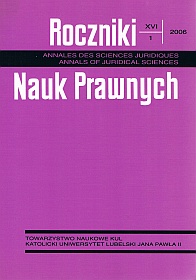Preparing Children and Adults for Accepting the Sacrament of Baptism in Catholic Eastern Churches
Abstract
The Catechism of the Catholic Church states that: “From the first Jerusalem community until the paruzja God's Churches, faithful to the Apostolic Creed, in all places celebrate the same Paschal Mystery. There is one mystery that is celebrated in liturgy, but forms of celebration are different. […] Various liturgical traditions were given rise to because of the very mission of the Church. Churches in the same geographical and cultural area started celebrating Christ's mystery using special forms of expression, typical of the given culture: in the tradition of the «deposit» of the faith, in the liturgical symbols, in organizing the brotherly community, in the theological understanding of the mysteries, and in different forms of sanctity (CCC 1200; 1202).
According to Canon 679 of the Eastern Churches Canon Code expressing the fundamental principle of the Church's teaching on baptism, every man who is not yet baptized is capable of accepting the sacrament. The Church's teaching that is generally and constantly professed says that both adults and children may be and should be baptized. “Instruction on the Use of Liturgical Regulations of the Eastern Churches Canon Code” issued by the Congregation for the Eastern Churches on 6 January 1996 says that the indication given in the Eastern Churches Canon Code that is different from what was often used, or even from the legislature that has been in force in the recent centuries, confirms the connection that exists between the three sacraments of the Christian initiation, which is also reflected in the way they are administered. It was a motivating factor in forming the code norms which suggest that the three sacraments: baptism, chrismation and the Holy Communion, should be received simultaneously or one shortly after another. It follows that when talking about preparation for receiving baptism we at the same time speak about the two remaining initiation sacraments, as the legislator recommends administering them during one celebration.
The Church that allows one to receive baptism and administers it, sets some requirements both to adults who want to accept baptism, and to those who ask for baptism to be administered to their children. The rules for administering and receiving baptism depend on whether it is an adult or a child who is going to accept it. This follows from the fact that an adult makes his own decision on receiving baptism and he accepts the commitments, whereas a child's parents or their legal representatives do so in the name of the child. This is why the requirements from adults are defined in a different way from the requirements that concern the child's parents.
Summing up the above considerations it should be stated that in Eastern Catholic Churches what in preparation concerns baptism, also concerns the remaining sacraments of Christian initiation, because, as the legislator orders: “Those who have been baptized should also receive the sacrament of chrismation, so that marked by the stamp of the Holy Spirit's gift, they could be witnesses and co-constructors of Christ's Kingdom” (ECCC, Canon 692). Additionally code norms say: “What concerns participation of children in Divine Eucharist after receiving baptism and chrismation, it is the liturgical books of one's own Church «sui iuris» that should be complied with, maintaining the proper care” (ECCC, Canon 719). In the tradition of Eastern Churches the First Holy Communion is administered together with the sacraments of baptism and chrismation, that is usually in infancy; hence it is difficult to find statements in the code norms that speak about preparation for receiving this sacrament.
For historical and cultural reasons the Western Church has neglected this practice and the initiation sacraments have been administered to children not simultaneously, but in various moments later on. However, in the East this old practice has been preserved unchanged and has never been stopped. The connection is strong enough to signify all the stages of Christian initiation in certain contexts.
Copyright (c) 2006 Roczniki Nauk Prawnych

This work is licensed under a Creative Commons Attribution-NonCommercial-NoDerivatives 4.0 International License.


